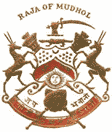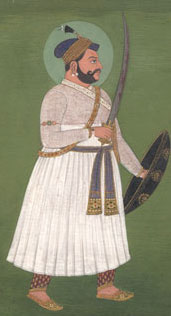
Links
BAJEE RAJE GHORPADE
EARLY HISTORY OF THE FAMILY, MUDHOL
AFTER Pratapsinha, Bajee Raja his son began to look to the Jahagir and service of his
father. His cousins, Abmbaji and Mansinha, were in Karnatic. Immediately
afterwards in A.D.1646, Mustafakhan was made the Commander-in-Chief of the
Bijapur armies which were sent to Karnatic for the purpose of extending the
dominions. Bajee Raja was specially deputed on this expedition. Shahaji Bhosale
also, with his detachment of three thousand, was in this expedition. A momentous
and bloody battle was fought at Antoor in which the enemies were defeated.
The
Commander-in-Chief of the armies was the well-known Velluvarraya. Malikrayan
also did his utmost in the fight. The detachment of Bajee Ghorpade did its share
of the fight creditably. Manasingji laid down his life in the battlefield.
The
victorious army drove the enemy before it and pursued them towards the Eastern
sea.
The enemies took Veloor on their way and turned towards Jinji. The Bijapur forces besieged this fort and carried on the operations strenuously. Though the siege lasted for months, there were no signs of capturing the fort. All the generals began to suspect that the besieged enemy must be getting help from outside. They placed spies to trace out the persons supplying help to the enemies. It came out that the besieged people got materials from the camp of Shahaji Raje Bhosale. The Brahmin statesman of Bijapur began to help the enemies through Shahaji Raje Bhosale. The conquered territory was vast and the Bijapur army was scattered throughout Karnatic. It would have taken much time for a fresh army to be brought on the scene of operations. On the other hand, the enemy would have gained ground if the siege had been raised.
Under these circumstances, the Commander-in-Chief Mustafakhan felt himself surrounded by difficulties. Shahaji Raje on his part began to show carelessness and acted independently. As soon as he heard that he was suspected and a fresh army was sent for, Shahaji left the siege without asking for or waiting for the orders of his Commander-in-Chief, excusing himself on the grounds that it was very long since his detachment was on duty and that there was great dearth in the camp. It could be clearly seen that Shahaji was bent upon joining the enemies and creating a disturbance. The Commander-in-Chief called a Council of War and called upon the generals assembled to take the individual responsibility of arresting Shahaji Raja. It was the custom to place betel-nut and leaves in front of the Council and the person undertaking to do the required risky job was to pick up the betel-nut and leaves. It happened that nobody came forward in the Council to undertake the arrest of Shahaji Raje. At last Bajee Raje and his cousin Ambaji Raje undertook the deed. They occupied the point of attack vacated by Shahaji’s army, and with a select cavalry of two thousand pursued close in search of the army of Shahaji. Towards sunrise the pursuers could discern Shahaji's army, which was frightened at the sight of the pursuing army and began to run away. In the hurly-burly Shahaji had safely escaped. Bajee Raje then entrusted the arrangement of the camp to Ambaji and Yeshawantrao Asatkhane and with a select band of cavalry he himself pursued Shahaji. He arrested Shahaji eventually and made him over to Mustafakhan. During this pursuit one thousand of Shahaji's people were killed. The Emperor was much pleased with Bajee Raje for this deed. Every article belonging to Shahaji fell into the hands of the Imperial troops without the least pillage. Afterwards, Shahaji was sent a captive to Bijapur together with all his belongings. In this way, Shahaji was frustrated in his plan of feigning flight and attacking the Imperial forces at night.
Shortly after this the fort as well as a vast territory came into the hands of the Bijapur Emperors. The expedition in Karnatic continued off and on till the death of Muhammad Adilshaha. All the generals returned to Bijapur on the death of the Emperor. Meanwhile, the Moghul Emperor Shahajhan sent a vast army: under the command of Aurangzeb and Mirzumla with the object of capturing Bijapur.
The Bijapur Court could not boast of unity among its nobles. Great generals had grounds of enmity against each other. Everyone was engaged in putting his own Jahagir in order. When the armies were in the Deccan the disputes arising in the Jahagirs of the Sardars on the battlefield were looked to and settled by the Subhedars of the Subhas in which the Jahagirs were situated. But seeing that Subhedars acted freely to the detriment of the Jahagirs, the Jahagirdars began to reserve half their forces in the Jahagir itself; consequently there was a lack of forces on the front. There were a few generals like the Ghorpades, who went to the front with the full strength of their armies. The Palegars in the Deccan saw that the armies had returned to Bijapur and took advantage of the situation in attempting to regain their lost territories. Shahaji Bhosale was the foremost in such attempts.
Owing to such lack of discipline, the Bijapur forces could not do justice to-themselves in fighting the Moghuls. A large number of Sardars secretly sided with the Moghuls while some openly joined the Moghul ranks. Such treacherous conduct naturally could not bring success to the Bijapur forces. The Moghul army besieged and captured Bedar, but the success cost many lives to the Moghuls. They came into possession of the inconsiderable wealth and a vast amount of ammunition in the fort. The Moghul army then marched towards Gulbarga and came in contact with the Bijapur forces. Many skirmishes were fought near Gulbarga.
The Moghuls marched towards the fort of Kalyani and laid siege to it. The Bijapur forces were marching slowly towards Kalyani intending to succour the besieged. One morning, Bajee Raje and Ambaji Raje saw that a Rajput general was carrying food-grains to the Moghul army. They attacked the commissary and had almost captured the whole of the army, but Aurangzeb, who was the Subhedar of the Deccan, hastened to the aid of the commissary. He temporarily raised the siege and with the whole army attacked the detachment of Bajee Raje. Only about 1,500 of Bajee Raje's cavalry survived the fateful day. The Moghul forces were triple in number to the cavalry of Bajee Raje still the small army heroically faced the Moghul force and killed a large number of the enemy. The detachment under Afzulkhan was foremost in the valour manifested on that day. The carnage continued till the evening. Then the Commander-in-Chief Khan Mahammad ordered a retreat. Immediately after this, negotiations were opened for peace and no battles took place afterwards. The Moghuls lost much during this Kalyani affair. Many of their well-known generals were killed on the battlefield. Aurangzeb, the Moghul Subhedar, stopped the warfare and declared peace.
While the Bijapur forces were engaged in these fights, disturbances arose in the Deccan. In H.1070 Shivaji succeeded in his plans against Afzulkhan and consequently his star was in the ascendant. A second expedition sent against him was also foiled by Shivaji who took possession of the fort of Panhala. Bajee Raje was appointed to subdue Shivaji. Bajee Raje with the intention of staying a day at Mudhol marched alone in front leaving the army to follow. Shivaji, who had kept a watch on the movements of Bajee Raje, marched with his army against Mudhol in the dead of night. The people in the fort took this army to be the front guard of the Bijapur forces and so the gates of the citadel were opened and Shivaji straightway rushed to the palace. He knew every nook and corner of the palace and consequently effected his entrance to the inner apartments, where Bajee Ghorpade was sleeping. He held up his sword against Bajee suddenly and killed him then and there heed-less of remonstrations against killing a disarmed enemy. (H.1072). Afterwards the four queens and six sons of Bajee Raje together with male and female relatives were put to death and the palace itself was set on fire. Having accomplished this, Shivaji returned to Panhala. As the whole army in the fort was quite unaware of the impending danger, there was no obstruction presented to the attacking enemy.
Much time had necessarily to be wasted before sending another general against Shivaji. The command of the expedition was given to Khavaskhan after Bajee Raja. Thus Shivaji was partly, if not fully, successful in annihilating the family of Bajee Ghorpade.
Alli Adilshaha then sent for the remaining wife and two sons of Bajee Raja who were living at Dhir in Northern India, Dhir being the place of Bajee Raja's wife. Adilshaha took the sons under his protection and conferred on them all the honours and dominions belonging to their father.